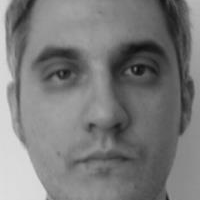International Journal of Information Engineering and Electronic Business (IJIEEB)
IJIEEB Vol. 8, No. 1, 8 Jan. 2016
Cover page and Table of Contents: PDF (size: 2207KB)
A Novel Approach to T2-Weighted MRI Filtering: The Classic-Curvature and the Signal Resilient to Interpolation Filter Masks
Full Text (PDF, 2207KB), PP.1-10
Views: 0 Downloads: 0
Author(s)
Index Terms
Magnetic Resonance Imaging, Human Brain Tumor, Classic-Curvature, CC, Signal Resilient to Interpolation, SRI, Filter Mask, Convolution
Abstract
This paper presents a novel and unreported approach developed to filter T2-weighetd Magnetic Resonance Imaging (MRI). The MRI data is fitted with a parametric bivariate cubic Lagrange polynomial, which is used as the model function to build the continuum into the discrete samples of the two-dimensional MRI images. On the basis of the aforementioned model function, the Classic-Curvature (CC) and the Signal Resilient to Interpolation (SRI) images are calculated and they are used as filter masks to convolve the two-dimensional MRI images of the pathological human brain. The pathologies are human brain tumors. The result of the convolution provides with filtered T2-weighted MRI images. It is found that filtering with the CC and the SRI provides with reliable and faithful reproduction of the human brain tumors. The validity of filtering the T2-weighted MRI for the quest of supplemental information about the tumors is also found positive.
Cite This Paper
Carlo Ciulla, Farouk Yahaya, Edmund Adomako, Ustijana Rechkoska Shikoska, Grace Agyapong, Dimitar Veljanovski, Filip A. Risteski, "A Novel Approach to T2-Weighted MRI Filtering: The Classic-Curvature and the Signal Resilient to Interpolation Filter Masks", International Journal of Information Engineering and Electronic Business(IJIEEB), Vol.8, No.1, pp.1-10, 2016. DOI:10.5815/ijieeb.2016.01.01
Reference
[1]G. Gerig, O. Kubler, R. Kikinis, and F.A. Jolesz, “Nonlinear anisotropic filtering of MRI data”, IEEE Transactions on Medical Imaging, vol. 11, no. 2, pp. 221-232, 1992.
[2]S. Rice, “S. Mathematical analysis of random noise”, Bell System Technical Journal, vol. 23, no. 3, pp. 282-332, 1944.
[3]D. Gensanne, G. Josse, J.M. Lagarde, and D. Vincensini, D. “A post-processing method for multiexponential spin-spin relaxation analysis of MRI signals” Physics in Medicine and Biology, vol. 50, no. 16, pp. 3755-3772, 2005.
[4]E. Fischi Gomez, “Inhomogeneity correction in high field magnetic resonance images: human brain imaging at 7 Tesla”, M.S. thesis, Universitat Politècnica de Catalunya, Barcelona, Spain, 2008.
[5]U. Vovk, F. Pernu?, and B. Likar, “A review of methods for correction of intensity inhomogeneity in MRI”, IEEE Transactions on Medical Imaging, vol. 26, no. 3, pp. 405-421, 2007.
[6]C. Ciulla, D. Veljanovski, U. Rechkoska Shikoska, and F.A. Risteski, “Intensity-curvature measurement approaches for the diagnosis of magnetic resonance imaging brain tumors”, Journal of Advanced Research, vol. 6, pp. 1045-1069, 2015.
[7]C. Ciulla, “Improved signal and image interpolation in biomedical applications: the case of magnetic resonance imaging (MRI)”, Medical Information Science Reference, IGI Global Publisher, Hershey, PA, USA, 2009.
[8]M. Catani, R.J. Howard, S. Pajevic, and D.K. Jones, “Virtual in vivo interactive dissection of white matter fasciculi in the human brain”, NeuroImage, vol. 17, pp. 77–94, 2002.
[9]M. Soret, S.L. Bacharach, and I. Buvat, “Partial-volume effect in PET tumor imaging”, Journal of Nuclear Medicine, vol. 48, pp. 932-945, 2007.
[10]Y. Assaf, and O. Pasternak, “Diffusion tensor imaging (DTI)-based white matter mapping in brain research: A review”, J. Mol. Neurosci., vol. 34, pp. 51-61, 2008.
[11]C. Pierpaoli, P. Jezzard, P.J. Basser, A. Barnett, and G. Di Chiro, “Diffusion tensor MR imaging of the human brain”, Radiology, vol. 201, no. 3, pp. 637-648, 1996.
[12]S. Pajevic, and C. Pierpaoli, “Color schemes to represent the orientation of anisotropic tissues from diffusion tensor data: Application to white matter fiber tract mapping in the human brain”, Magnetic Resonance in Medicine, vol. 42, pp. 526-540, 1999.
[13]D. Chien, K.K. Kwong, D.R. Gress, F.S. Buonanno, R.B. Buxton, and B.R. Rosen, “MR diffusion imaging of cerebral infarction in humans”. AJNR, vol. 13, pp. 1097-1102, 1992.
[14]C.A. Clark, M. Hedehus, and M.E. Moseley, “In vivo mapping of the fast and slow diffusion tensors in human brain”, Magnetic Resonance in Medicine, vol. 47, no. 4, pp. 623-628, 2002.
[15]P.M. Thompson, and A.W. Toga, “Detection, visualization and animation of abnormal anatomic structure with a deformable probabilistic brain atlas based on random vector field transformations” Medical Image Analysis, vol. 1, no. 4, pp. 271-294, 1997.
[16]J.L. Lancaster, L.H. Rainey, J.L. Summerlin, C.S. Freitas, P.T. Fox, A.C. Evans, A.W. Toga, and J.C. Mazziotta. “Automated labeling of the human brain: A preliminary report on the development and evaluation of a forward-transform method”, Human Brain Mapping, vol. 5, no. 4, pp. 238-242, 1997.
[17]J.L. Lancaster, M.G. Woldorff, L.M. Parsons, M. Liotti, C.S. Freitas, L. Rainey, P.V. Kochunov, D. Nickerson, S.A. Mikiten, and P.T. Fox, “Automated Talairach atlas labels for functional brain mapping”, Human Brain Mapping, vol. 10, no. 3, pp. 120-131, 2000.
[18]J. Mazziotta, A. Toga, A. Evans, P.T. Fox, J. Lancaster, K. Zilles, R. Woods, et al., “A probabilistic atlas and reference system for the human brain: International consortium for brain mapping (ICBM)”, Philosophical Transactions of the Royal Society of London, Series B: Biological Sciences, vol. 356, no. 1412, pp. 1293-1322, 2001.
[19]B. Stieltjes, W.E. Kaufmann, P.C.M. van Zijl, K. Fredericksen, G. D. Pearlson, M. Solaiyappan, and S. Mori, “Diffusion tensor imaging and axonal tracking in the human brainstem”, NeuroImage vol. 14, pp. 723-735, 2001.
[20]D.S. Tuch, V.J. Wedeen, A.M. Dale, J.S. George, and J.W. Belliveau, “Conductivity tensor mapping of the human brain using diffusion tensor MRI”, PNAS, vol. 98, no. 20, pp. 11697–11701, 2001.
[21]G. Agyapong, “Calculation of the classic-curvature and the intensity-curvature term before interpolation of a bivariate polynomial”, International Journal of Information Engineering and Electronic Business, vol. 7, no. 6, pp. 37-45, 2015.






